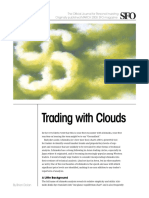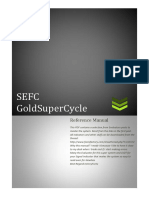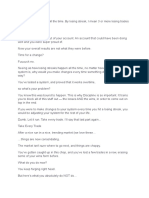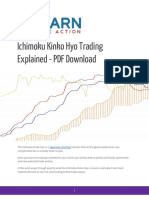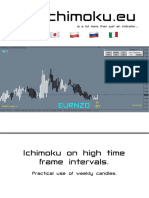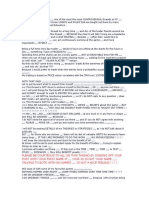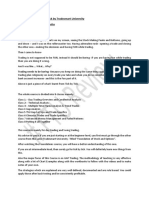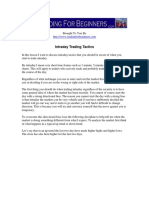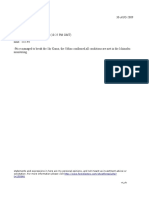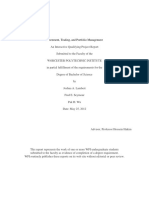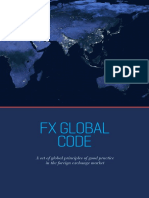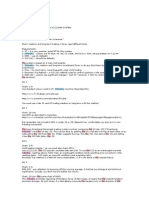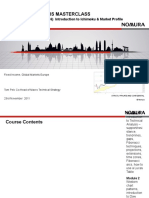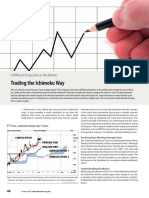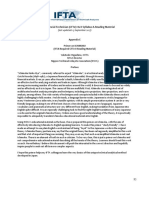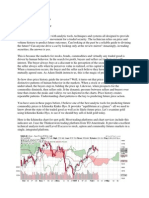Japanese Trading Systems Class 1
Class 1: Introduction
In This Lesson:
• History of Japanese Trading
• Candlesticks meet Clouds
• Introduction to Cloud Charts
• How to Build a Cloud
PAGE 1
�Japanese Trading Systems Class 1
The Rich History of Japanese Trading
Political Unrest
• Trading in Japan evolved out of extreme political unrest
• From around 1600-1868
• Known as the “Edo Period”
• Japan was cut off from the rest of the world
• Emphasis on Central Government
Count the Rice
• All land was assessed and taxed for their yield
of rice crops.
• Peasants paid 40% in rice tax.
• Finance, Commerce, and trade grew exponentially
with the pooling of resources.
• Rice became the primary currency of choice.
Dojima Rice Exchange
• The rice trade led to the creation of the Dojima Rice Exchange.
• Seen as a forerunner of modern banking
• Established in 1697
• Played a major role in the modernization of Japanese banking
• An early concept in futures trading
PAGE 2
�Japanese Trading Systems Class 1
Paid in Rice?
• The culture at the time used rice as the primary trading tool in
place of currency.
• A rice surplus might be stored in the “rice bank.”
• In exchange for a deposit the bank customer would
receive a note.
• These “notes” could be traded as money.
Cash, Backed by Rice
• In America, the US Dollars were backed
originally by Gold.
• In 1700 Japan, this paper currency
(Hansatsu) was backed by rice.
• Unlike Gold, the production of rice can
fluctuate heavily.
• This leads to a shift in currency value.
Trade the Future of Rice
• As crop yields would fluctuate, the value of the “hansatsu”
(Paper money) fluctuated
• As you know, price fluctuation is an opportunity to make money!
• This is why the rice trading exchange was so huge and important
in Japan
PAGE 3
�Japanese Trading Systems Class 1
Tools of the Trade
• The Japanese quickly began tracking value fluctuations
• They tracked the Open, High, Low, and Closing trade prices for the day
• As they plotted them, they developed a system for documenting the prices
A “Black” Candle is actually “full” vs a white candle which is “open”
Candlesticks
• Candlesticks were used to track the trade
• The picturesque nature of the candles told a story about the trading sentiment
• The result - a very visual form of trading, based on the fluctuation of “what people were
willing to trade for”
Candlestick Trading
• One of the earliest forms of technical trading
• The most developed early form of technical trading
• Just as valuable today as it was in 1710!
• Depicts in pictures, what the trading sentiment is of
the instrument you are trading
PAGE 4
�Japanese Trading Systems Class 1
Candlestick Evolution
• Candlestick trading evolved into a very
complete form of technical trading.
• Many of the developments are nearly
identical to what ultimately developed in
the west.
• Chart patterns like “3 Mountain Tops” or
“Three Buddha Tops.”
Sakata Method
• Developed by Sokyu Honma (1724-1803)
• Famous Japanese Trader
• Wrote a book translated “The Three Monkey Record
of Money”
• He argues “psychological factors are the reason for
price movement”
• Lays out the Sakata Method
Japanese Evolution
• Throughout the 1800s techniques evolved
• Kagi, Renko, 3-line break, and Heiken-Ashi are all similar to western Point & figure
• Then in 1940 another breakthrough
Rich History of Japanese Trading
Meet Mr. Sanjin
• Japanese Journalist in 1940s
• Wanted a trend following system to compliment candlesticks
• Needed something to quickly outline the bigger trend
• Ichimoku Clouds are the result!
• Ichimoku means “at a glance”
PAGE 5
�Japanese Trading Systems Class 1
Ichimoku Kinko Hyo
• Ichimoku = “At a glance”
• Kinko = “Balance”
• Also Called:
➡ Ichimoku Charts
➡ Ichimoku Clouds
➡ Cloud Charts
Why Ichimoku?
• Candles are very valuable
• Candles only focus on the short term swing
• It is easy to get “too close” to the trade
• “Can’t see the forest for the trees!”
In the Clouds
• Clouds are a medium to long-term tool
• Outline the larger trend
• Present Support & Resistance levels
• Serve as a “gate” to help confirm a primary trend direction
With Candles
•Ichimoku Clouds are intended to be used
with candles
•They add a big picture perspective to the
candle data
•You should already be familiar with your
candle patterns - we will not review patterns
in this program
PAGE 6
�Japanese Trading Systems Class 1
Introduction to Ichimoku Clouds
At A Glance
Ichimoku Clouds provide: Components of the
• Support & Resistance Ichimoku Cloud
• Trend Identification:
Comparison of the current
➡ Up Historical Component
price to historical price
➡ Down
➡ sideways Current Component Reflection of current trend
• Buy/sell signals
• Volatility Future insight into trend
Future Component sentiment & support &
• Stop Location resistance
PAGE 7
�Japanese Trading Systems Class 1
Components of the Ichimoku Cloud
• Historical: • Future “the cloud”:
➡ Called “Chikou Span” ➡ Made up of 2 lines:
➡ Compares current price to ➡ 1) Senkou A
historical price
➡ 2) Senkou B
➡ Represents momentum in price
➡ Derived from Tenken & Kijun Lines
➡ Indicates support & resistance
signals ➡ Anticipate Support & resistance
➡ Form the cloud
➡ Helps signal a trend “in the clear”
➡ Signals current & future sentiment
• Current:
➡ Signals of strength vs weakness
➡ Made up of 2 lines:
➡ 1) Tenken Sen • The Candles:
➡ Candles are the actual price data
➡ 2) Kijun Sen
➡ Every line is derived from the data
➡ Variations of Moving Averages
seen in the candle
➡ Provide basic MA data of trend
➡ Candles will signal reversals
➡ Indicates MA cross signals
➡ Signal day to day sentiment
➡ Useful for stops
➡ Everything you have already
➡ The foundation to the other lines learned about candles applies
The Best Success:
• Use all of the signals together
• Not using all of the signals will give incomplete trade insight
• Be sure to interpret the candles as well - they are a critical component
PAGE 8
�Japanese Trading Systems Class 1
How to Build a Cloud
Constructing the Chart
• Every Cloud chart is made up of 5 lines
1. Tenkan-sen
2. Kijun-sen
3. Senkou A
4. Senkou B
5. Chikou
• PLUS the candlesticks
Tenkan-Sen
• A variation on a simple moving average
• The Average uses a “mid-point” price
• Tenkan-sen uses a 9 Day setting
• Average mid-price of last 9 sessions
9 day High + 9 day Low
2
Mid-Price Moving Average
PAGE 9
�Japanese Trading Systems Class 1
PAGE 10
�Japanese Trading Systems Class 1
Kijun-Sen
• Same formula as the Tenken-sen
• Uses a 26 session calculation
• Often called the “standard” or “Base line”
26day High + 26 day Low
PAGE 11
�Japanese Trading Systems Class 1
Together
• Tenken & Kijun provide the “current” portion of Ichimoku.
• Work very much like a moving average
• We get some signals from these two lines but they are most important as the foundation
for the other 3 lines.
“The Cloud”
• The “cloud” portion is made up of two lines:
➡ Senkou A
➡ Senkou B
• Both lines are plotted 26 days in the future
PAGE 12
�Japanese Trading Systems Class 1
Senkou A
• The first line of the cloud
• An average of the Tenken & Kijun lines
• Plotted 26 sessions in the future
( Tenken + Kijun
2 ) 26 Days Forward
PAGE 13
�Japanese Trading Systems Class 1
Senkou B
• The second line of the cloud
• Calculate like Tenkan & Kijun
• Plotted 26 sessions in the future
( )
• Uses 52 period mid-point average
52 day high + 52 day low
26 Days Forward
2
PAGE 14
�Japanese Trading Systems Class 1
Together
• Senkou A & B create the “cloud”
• This is the “future” portion of Ichimoku
• Forms a key part of the system
• Serves several functions:
➡ Support & Resistance
➡ Bullish/Bearish signals
➡ Cloud Thickness
PAGE 15
�Japanese Trading Systems Class 1
Chikou
• Chikou is the lagging line
• Closing price of chart
• Shifted backwards 26 days
26 Days Backwards Closing Price
PAGE 16
�Japanese Trading Systems Class 1
All Together
• Together everything creates the Ichimoku Kinko Hyo picture
• “At a glance” we can now interpret a lot of data
• We get buy & sell signals, support & resistance, consolidation, and more
Homework
• Set up the Ichimoku Clouds in your charting software
• Watch “How to” videos in the members area for your software
• Come to next class ready to learn about the signals!
PAGE 17
